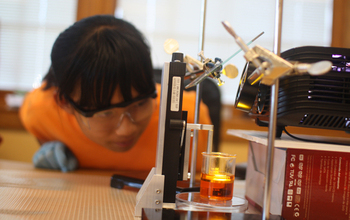All Images
Research News
3-D printing and custom manufacturing: from concept to classroom

A middle-school student at the Next Generation School in Champaign, Ill., creates a 3-D object with a classroom 3-D printer. Students in grades K-12 can "print" 3-D objects from computer-generated sources right in the classroom using a rapid prototyping or 3-D lithography process. The process is based on a research project that was headed by Nicholas Fang, an assistant professor in the Mechanical Engineering Lab at the University of Illinois at Urbana-Champaign and developed at the Center for Nanoscale Chemical-Electrical-Mechanical Manufacturing Systems (NanoCEMMS) at the university. NanoCemms is a National Science Foundation Nanoscale Science and Engineering Center.
The process uses UV sensitive monomer to do a form of 3-D printing called microstereo lithography. The students use a video projector with a UV output to create incredibly thin polymer layers (on the order of 400 nanometers) and build objects layer by layer. The activity demonstrates the basic challenges of nanoscale engineering.
The 3-D printing process has already been used by hundreds of students in Illinois at all grade levels to turn mathematical models into objects that they can touch and feel.
Nano-CEMMS provides a wide range of human resource development activities targeted toward increasing both the diversity of students involved with the center and educational opportunities at the K-12 and undergraduate levels, as well as providing graduate students with teaching experience in an emerging field. To learn more about the center, visit the Nano-CEMMS website. [Research supported by NSF grant CMMI 07-49028, awarded to John Rogers. Date of project shown in image: 2008-2010]
Credit: Joe Muskin, University of Illinois
Download the high-resolution JPG version of the image. (4.5 MB)
Use your mouse to right-click (Mac users may need to Ctrl-click) the link above and choose the option that will save the file or target to your computer.

The National Science Foundation has provided early and continuous support to the field of additive manufacturing, leveraging strategic investments in basic research, education, small business and workshops to change the way we make everything from medical devices to automotive parts.
*This figure has been modified and reproduced with permission from the Institute for Defense Analyses Science and Technology Policy Institute. It originally appeared in the 2013 report: The Role of the National Science Foundation in the Origin and Evolution of Additive Manufacturing in the United States.
Credit: Institute for Defense Analyses Science and Technology Policy Institute
Download the high-resolution JPG version of the image. (68.9 KB)
Use your mouse to right-click (Mac users may need to Ctrl-click) the link above and choose the option that will save the file or target to your computer.
Wind turbines the size of football fields, fuel efficient airplanes and safer vehicles are all examples of how advanced materials now make our daily lives a little better. Engineer Thomas Kurfess, who served as the Assistant Director for Advanced Manufacturing in the Office of Science and Technology Policy in the Executive Office of the President, explains.
Credit: NSF
Download the high-resolution JPG version of the image. (11.7 KB)
Use your mouse to right-click (Mac users may need to Ctrl-click) the link above and choose the option that will save the file or target to your computer.
For every dollar in manufacturing value added, $1.48 in additional value is created in other sectors, according to the U.S. Department of Commerce. Engineer Thomas Kurfess, who served as the Assistant Director for Advanced Manufacturing in the Office of Science and Technology Policy in the Executive Office of the President, explains why innovation in advanced manufacturing is tied to economic prosperity and national security.
Credit: NSF
Download the high-resolution PNG version of the image. (885.2 KB)
Use your mouse to right-click (Mac users may need to Ctrl-click) the link above and choose the option that will save the file or target to your computer.


